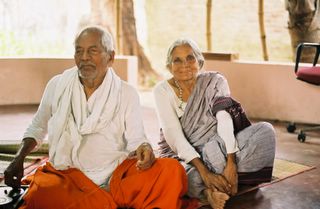The Wedding

And since the death of the founder, the running of the ashram has passed into the hands of female sannyasis, first through Jagannathan’s two sisters, and then later to others. In fact, this will be a wedding like no other I have ever seen, for it will all be presided over by women, and (as far as I am aware) none of them brahmins.
The Jagannathan family tree, somewhat like Krishnammal’s only more so, is virtually impossible for outside westerners to comprehend, with cousins marrying cousins, uncles nieces, in all various combinations. This particular marriage is one of the most traditional varieties – mother’s brother’s son marrying sister’s daughter. It is likely not quite a fully arranged nor entirely a love match. Either the bride or groom could refuse, but it is always thought best to keep wealth within the family, and so this kind of match is strongly encouraged.
The wedding starts with a procession of musicians – two nadaswarams and a large folk drum beaten with sticks, followed by the bride and groom in traditional garb. The music will remain very loud during the entire ceremony, and I seem to know much of it from my veena-playing days.

Much of the wedding, though in traditional form (abbreviated) seems to be run by the two video photographers hired for the job. First the groom comes, and, with the bride, washes the father and mother of the bride’s feet with milk, followed by decorating them with a red powder. Then the process is reversed and the groom’s parents’ feet are done in similar fashion. Then the bride and groom are seated, and gifts are given by the bride’s parents to the groom. A ritual fire is lit by one of the bright orange-garbed sannyasis. The groom puts his arm around the bride’s head, and places a dot of red powder on her forehead, between her eyes.
 Then they stand up, and the hem of the bride’s sari is tied to the edge of one of the groom’s garments. Then they are led, first the groom and the bride following, around the altar seven times by one who we might think of as the best man, in this case, an older male cousin. They stop after the third time and there is an exchange of rings – the bride puts a ring on the big toe of the groom, the groom a ring on the fourth toe (the “beauty” toe in Hindu lore) of the bride. He has trouble making it fit, but finally manages it.
Then they stand up, and the hem of the bride’s sari is tied to the edge of one of the groom’s garments. Then they are led, first the groom and the bride following, around the altar seven times by one who we might think of as the best man, in this case, an older male cousin. They stop after the third time and there is an exchange of rings – the bride puts a ring on the big toe of the groom, the groom a ring on the fourth toe (the “beauty” toe in Hindu lore) of the bride. He has trouble making it fit, but finally manages it.
After the seven circumnavigations of the altar, the two are brought to the presiding sannyasi for a benediction, and they are married!
Afterwards, Krishnammal (and then I!) are invited to place more red powder marks on the foreheads of the bride and groom and drop some rice on their hair. (I have actually met the groom – he must have been around 12 at the time, and know his now Denmark-residing brother from the Right Livelihood Award ceremonies in Stockholm.) It is indeed a great honor, especially since Krishnammal is not actually even a member of the family, nor am I. But we are now!
There is a large meal awaiting us, but we bow out beforehand, at 9:45 A.M. We have another long day ahead of us.


0 Comments:
Post a Comment
<< Home